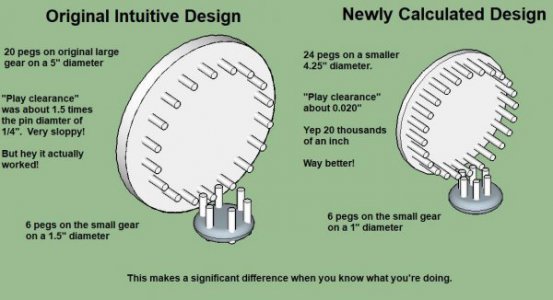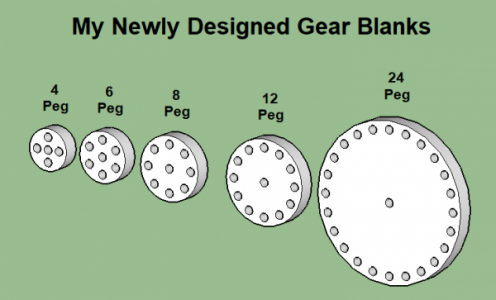- Joined
- Feb 18, 2016
- Messages
- 451
You have to hand it to the Medieval craftsman to design a working gear without the aid of CAD or complicated mathematics.
It does appear to be an easy design on the surface. I only built this one peg gear clock, and I basically built it just off the top of my head using simple obvious math. Without even really taking pin clearance into consideration much. I basically just focused on the pin spacing intuitively to make sure the pins didn't crash into each other. No fancy math. And it did work. It was binding up a little bit in certain places, but I think that was mainly due to lack of precision when drilling the pin holes.
These formulae you've pointed to account for pin length, and pin diameter, etc. You can get pretty carried away with these equations to design the best possible geometry. And that's what I would like to do just for fun and the learning process. This might be especially useful if I eventually move over to making metal pin or peg gears where it's best to get things right the first time through. With the wooden peg gears you can always do a little shaving or sanding where needed. That's a little more trouble with metal pins.
I'm just fascinated with antique technologies.
If you find anymore detailed information on making pin or peg gears I'd really appreciate it if you could post a link to it. These pin gears kind of caught my interest as novelty art. So it's something I'm looking forward to playing with. I've also recently become interested in building Stirling engings and Steampunk art. And so I might like to incorporate pin gears in those projects as well. It's all just for novelty and art.
The page you've provided is the best page I've seen yet in terms of giving some really nice equations to work with. Especially since that page addresses the 90 degree angle gears. I imagine there is probably more detailed info out there somewhere that addresses more complex pin gear configurations. I just haven't been able to find much.
Also, is there a difference between a "Pin Gear", and a "Peg Gear"? Or is that just interchangeable nomenclature? It's definitely an area of study I would like to read up on as much as I can. I'm looking forward to some day making metal pin gears, but I want to gain experience with wooden models first.




